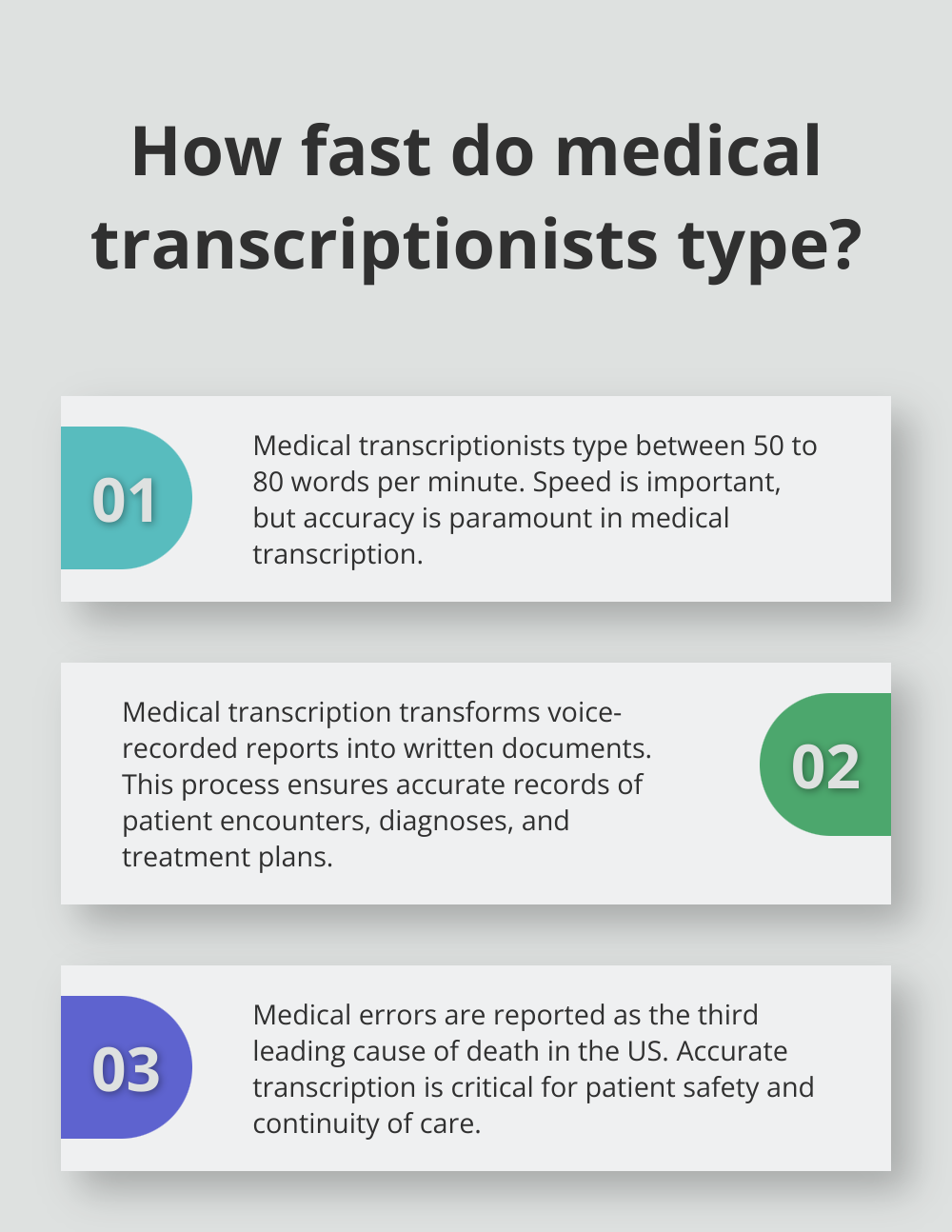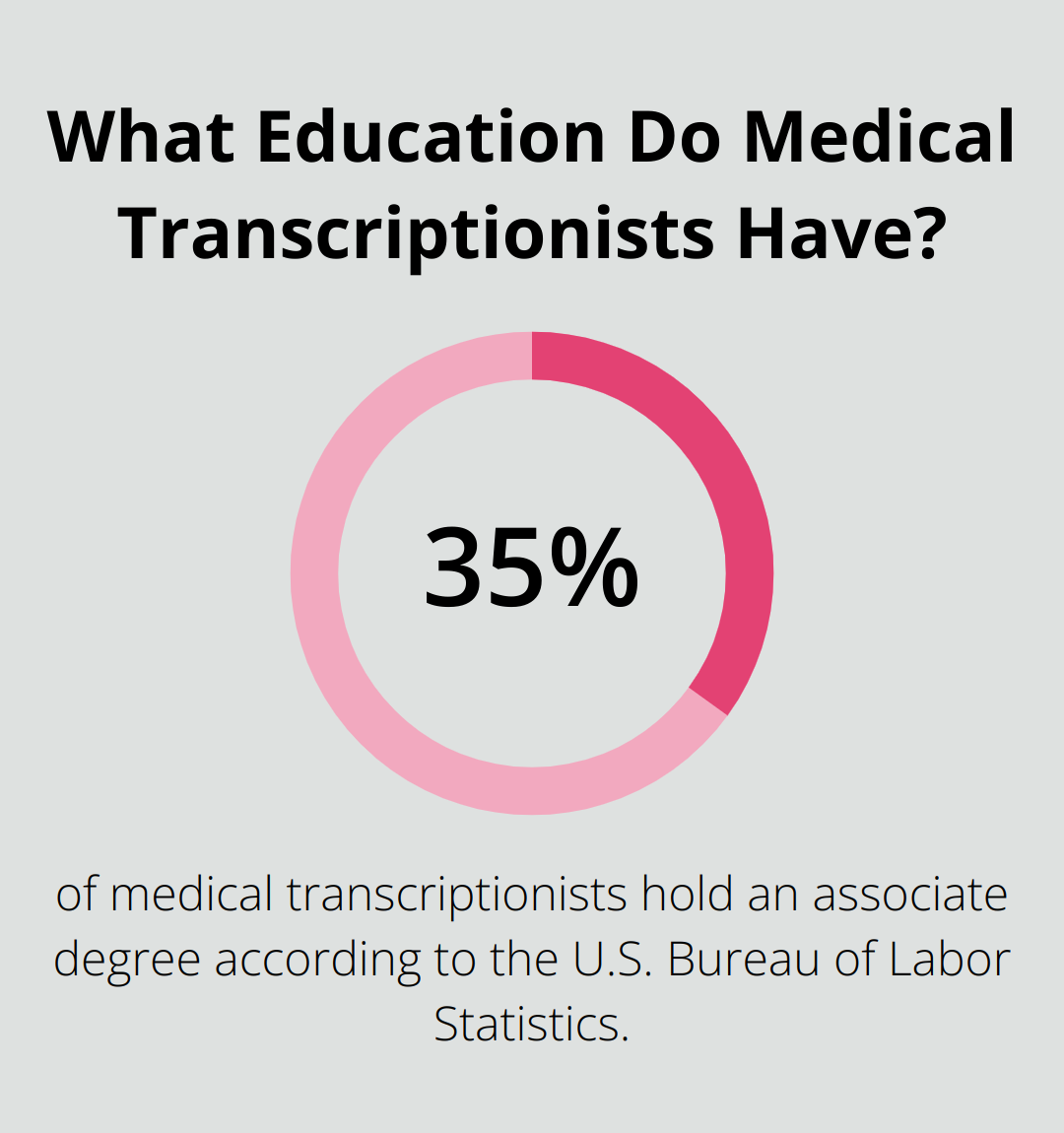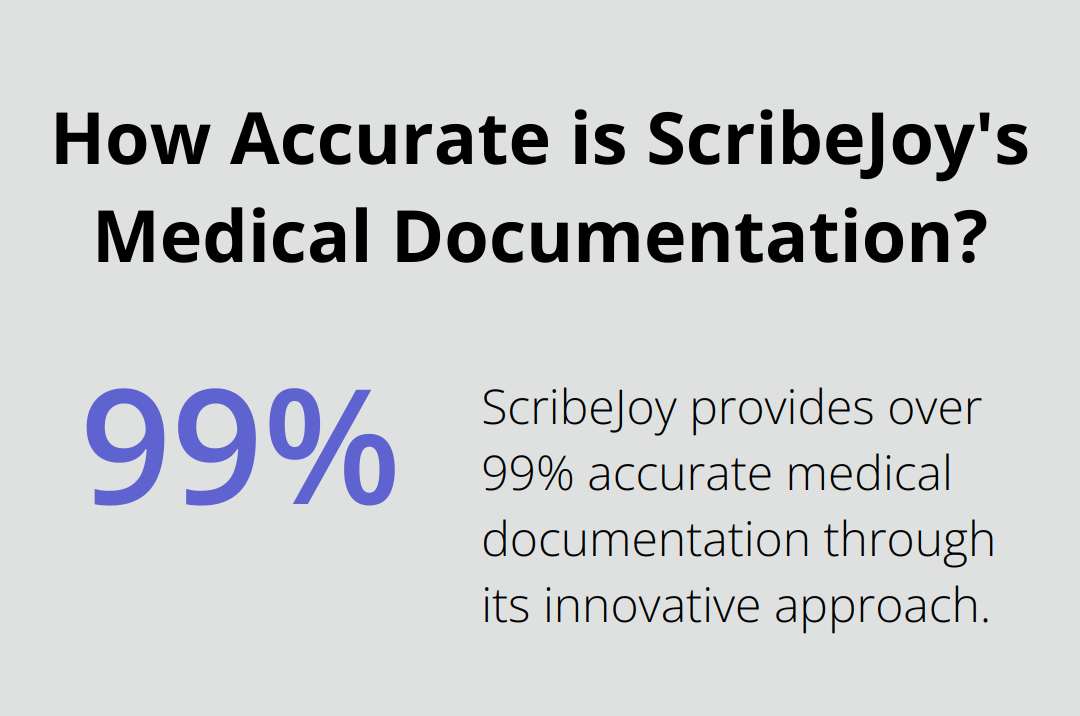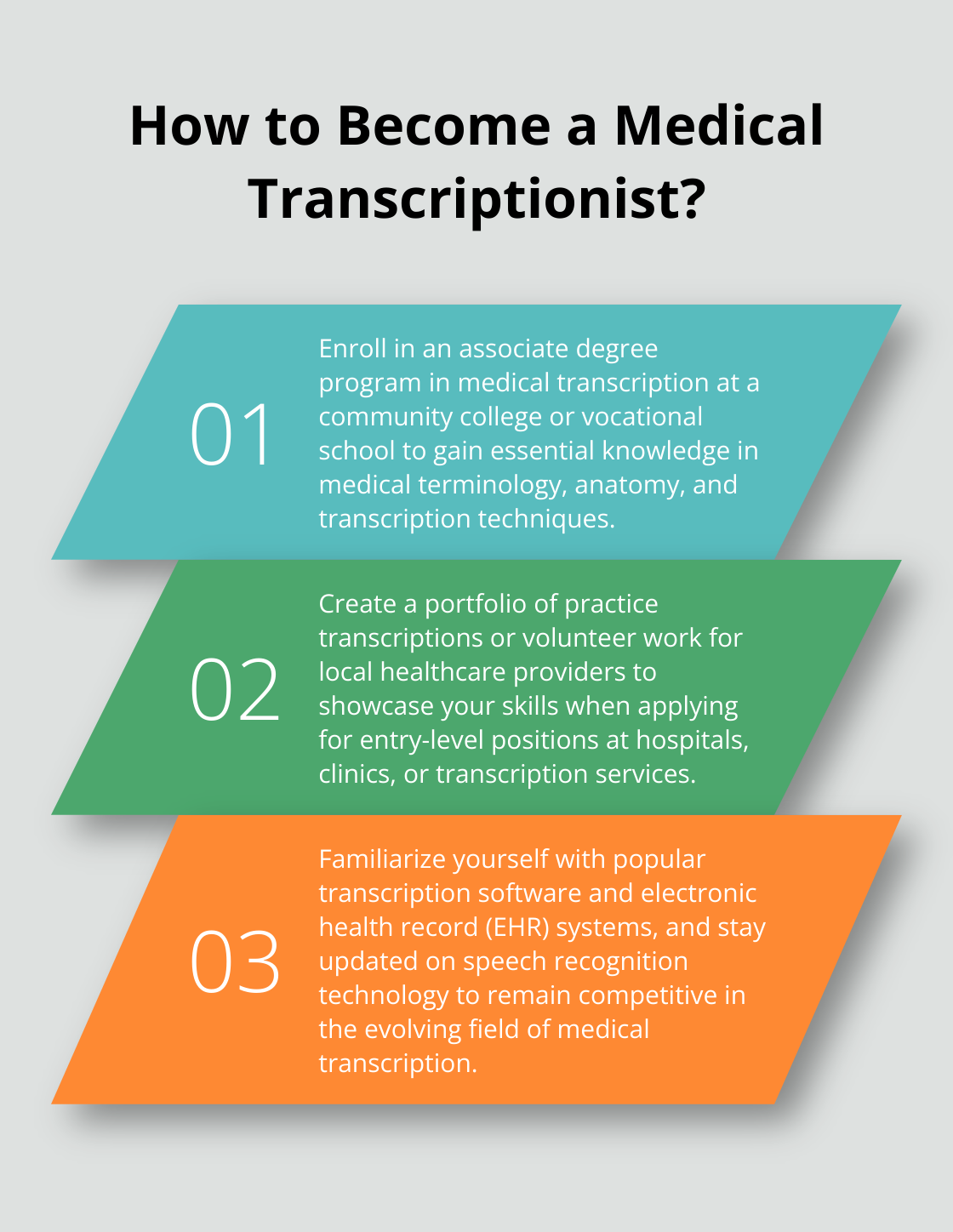Medical transcription work is a vital component of the healthcare industry, transforming spoken medical records into accurate written documents. At ScriberJoy, we’ve seen firsthand how this field offers a unique blend of medical knowledge and language skills.
Starting a career in medical transcription can open doors to flexible work arrangements and opportunities for growth in the healthcare sector. This guide will walk you through the essential steps to launch your journey in this rewarding profession.
What Is Medical Transcription?
Definition and Process
Medical transcription transforms voice-recorded medical reports into written documents. This process ensures healthcare providers have accurate, written records of patient encounters, diagnoses, and treatment plans.
The Importance of Accurate Documentation
Accurate medical documentation forms the foundation of effective healthcare. It’s not just about record-keeping; it impacts patient safety, continuity of care, and legal protection. Medical errors have been recognized as a serious public health problem, reported as the third leading cause of death in the US. This statistic highlights the critical nature of precise transcription.
Essential Skills for Medical Transcriptionists
To excel in medical transcription, professionals need a unique skill set. A strong grasp of medical terminology is essential. Transcriptionists deal with complex medical jargon daily, requiring familiarity with terms across various specialties.

Typing speed and accuracy are also critical. The average medical transcriptionist types between 50 to 80 words per minute. However, speed isn’t everything; accuracy is paramount. Even a small error in dosage or diagnosis can lead to serious consequences.
Attention to detail stands out as another crucial skill. Transcriptionists must catch subtle differences in similar-sounding terms and decipher often unclear audio.
The Role of Technology
While human skills remain essential, technology plays an increasingly significant role in medical transcription. Speech recognition software has become more sophisticated, but it’s not infallible. Human expertise complements these tools to ensure the highest level of accuracy.
For instance, ScribeJoy combines AI technology with human verification to achieve over 99% accuracy in medical documentation. This blend of technology and human expertise represents the future of medical transcription, offering both efficiency and precision.
Impact on Healthcare Efficiency
Efficient medical transcription significantly affects healthcare delivery. It allows doctors to see more patients, as they spend less time on paperwork. Accurate and timely transcription can help reduce this administrative burden.
Moreover, well-documented patient records facilitate better communication among healthcare providers. This improved communication can lead to better patient outcomes and reduced medical errors.
As we move forward, it’s clear that the field of medical transcription continues to evolve. The next section will explore the education and training requirements necessary to embark on this dynamic career path.
How to Get Educated in Medical Transcription
Formal Education Options
Medical transcription requires a solid foundation of knowledge and skills. While not always mandatory, formal education can significantly boost your career prospects and earning potential. Many community colleges and vocational schools offer associate degree programs in medical transcription. These programs typically take two years to complete and cover essential topics like medical terminology, anatomy, pharmacology, and transcription techniques.

The Association for Healthcare Documentation Integrity (AHDI) offers two key certifications:
- Registered Healthcare Documentation Specialist (RHDS) for entry-level professionals
- Certified Healthcare Documentation Specialist (CHDS) for those with more experience
According to the U.S. Bureau of Labor Statistics, about 35% of medical transcriptionists hold an associate degree. This education can give you a competitive edge in the job market and potentially lead to higher-paying positions.
Online Courses and Self-Study Resources
For those seeking more flexibility, online courses provide a viable alternative. Many platforms offer medical transcription courses from reputable institutions. These self-paced programs allow you to learn while balancing other commitments.
Self-study resources are also abundant. Medical dictionaries, anatomy textbooks, and online forums can supplement your learning. Many websites offer free resources and practice exercises to hone your skills.
The Importance of Continuing Education
The medical field constantly evolves, and so must your knowledge. Continuing education is not just beneficial-it’s essential for staying competitive. Many employers require ongoing training, and certifications often need regular renewal.
AHDI offers continuing education credits through webinars, conferences, and online courses. These not only keep your skills sharp but also provide networking opportunities with other professionals in the field.
Adapting to Technological Changes
Technology reshapes medical transcription. You must familiarize yourself with speech recognition software and electronic health record systems. Some transcriptionists transition into roles as medical scribes or documentation specialists, highlighting the importance of adaptability in this field.
Transcriptionists who continuously update their skills tend to produce more accurate work and adapt more easily to new technologies. This commitment to ongoing learning not only improves job performance but also opens doors to advancement opportunities within the healthcare documentation field.
As you consider your educational path in medical transcription, it’s important to also think about how you’ll build your career in this field. Let’s explore the various career opportunities and progression paths available to medical transcriptionists.
Launching Your Medical Transcription Career
Finding Your First Job
Starting a career in medical transcription requires a combination of education and practical skills. Hospitals, clinics, and transcription services often offer junior positions where you can gain valuable experience. These roles typically involve transcribing simpler medical reports under supervision.

To stand out in the job market, create a portfolio of your work. This can include practice transcriptions or volunteer work for local healthcare providers. Job search websites regularly list medical transcription positions, both entry-level and advanced.
Exploring Freelance Opportunities
Medical transcription allows for various work arrangements, including freelance and remote positions. Online platforms often have listings for medical transcription projects. These platforms can help you build your client base and gain experience across different medical specialties.
When working as a freelancer, set competitive rates. According to the U.S. Bureau of Labor Statistics, the median annual wage for health information technologists and medical registrars was $62,990 in May 2023. However, rates can vary based on experience, specialization, and turnaround time.
Advancing Your Career
As you gain experience, opportunities for career advancement emerge. Many transcriptionists progress to roles such as quality assurance editors, team leads, or even managers in transcription services. Specializing in high-demand areas (like radiology or oncology) can also lead to higher-paying positions.
Continuous learning propels career growth. Stay updated with the latest medical terminology and transcription technologies. Professional associations offer various continuing education opportunities that can enhance your skills and marketability.
Embracing Technology
Technology continues to shape medical transcription. Speech recognition software has become increasingly sophisticated, changing the nature of the job. Instead of typing every word, many transcriptionists now edit and review AI-generated transcripts for accuracy.
Familiarize yourself with popular transcription software and electronic health record (EHR) systems. Modern platforms combine AI technology with human expertise, offering opportunities for transcriptionists to work with cutting-edge tools while ensuring high accuracy. For instance, ScribeJoy stands out as a top choice in this field, providing over 99% accurate medical documentation through its innovative approach.
Building a Professional Network
Networking plays a vital role in career development. Join professional associations related to medical transcription and healthcare documentation. These organizations often provide resources, job boards, and networking events that can help you connect with potential employers and colleagues.
Attend industry conferences and webinars to stay informed about the latest trends and technologies in medical transcription. These events also offer excellent opportunities to meet other professionals in the field and learn about new job openings.
Final Thoughts
Medical transcription work combines healthcare knowledge with language skills. This career path starts with a strong foundation in medical terminology, anatomy, and transcription techniques. Formal education and certifications enhance your expertise and open doors to better opportunities in the field.

Entry-level positions and freelance work provide practical experience and help build your portfolio. Professional associations offer networking opportunities and keep you informed about industry trends. Adapting to technological advancements, especially in speech recognition software, will help you stay competitive in this evolving field.
The future of medical transcription blends technology with human expertise. ScribeJoy exemplifies this approach, achieving high accuracy in medical documentation. Your attention to detail and commitment to accuracy will contribute significantly to healthcare efficiency (and patient care).

Leave a Reply
You must be logged in to post a comment.